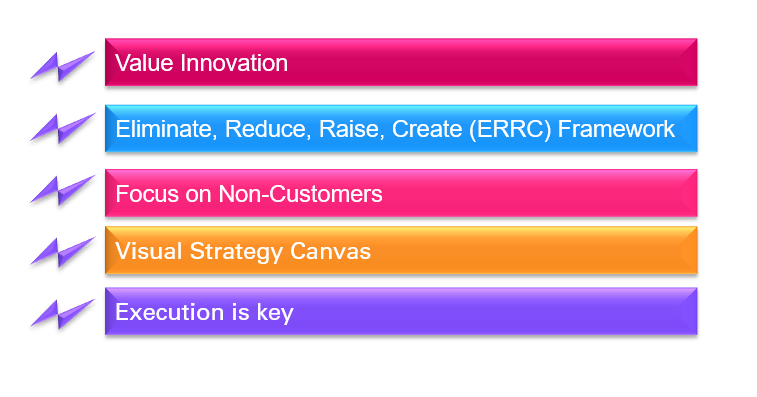In earlier posts, we learned about Porter’s five forces that help to understand industry competition business. In the competitive business landscape, finding untapped market opportunities and standing out from the crowd can be challenging. However, with the implementation of the Blue Ocean Strategy, businesses can chart new paths to success. In this blog post, we will explore the concept of the Blue Ocean Strategy, its core principles, and how it can transform the way companies compete in the market.
What is the Blue Ocean Strategy? Blue Ocean Strategy, coined by professors W. Chan Kim and Renée Mauborgne, is a groundbreaking approach that encourages businesses to create uncontested market space, where competition becomes irrelevant. Unlike the “red ocean” of bloody competition, the “blue ocean” represents untapped market potential and fresh opportunities.
Understanding the Core Principles:

- Value Innovation: Blue Ocean Strategy emphasizes the simultaneous pursuit of differentiation and low cost. It challenges the notion that businesses must choose between differentiation (offering unique value) or low cost. Instead, it encourages creating innovative offerings that provide exceptional value at a lower cost.
- Eliminate, Reduce, Raise, create (ERRC) Framework: To formulate a Blue Ocean Strategy, companies must examine four key actions using the ERRC framework. They need to identify factors to eliminate, reduce, raise, and create to differentiate their offerings from existing market norms and create new value for customers.
- Focus on Non-Customers: Rather than solely focusing on existing customers, Blue Ocean Strategy prompts companies to consider non-customers. By understanding the needs, pain points, and preferences of non-customers, businesses can tap into vast new markets that were previously overlooked.
- Visual Strategy Canvas: The Strategy Canvas is a visual tool that illustrates the competitive landscape of an industry. Blue Ocean Strategy encourages businesses to analyze the Strategy Canvas of their industry to identify areas of differentiation and uncover new market spaces.
- Execution is Key: Blue Ocean Strategy emphasizes that execution is as crucial as strategy formulation. Companies need to effectively implement their Blue Ocean Strategy and align their entire organization behind it to achieve success.
Real-World Examples:
- Cirque du Soleil: By redefining the circus experience, Cirque du Soleil eliminated traditional circus elements like animal acts and focused on artistic performances, appealing to a broader audience, and creating a new blue ocean of entertainment.
- Southwest Airlines: Southwest Airlines revolutionized the airline industry by eliminating services like in-flight meals and assigned seating, reducing costs, and offering affordable air travel to a vast market of budget-conscious travelers.
- Apple’s iTunes: Apple’s introduction of iTunes disrupted the music industry by creating a digital platform that eliminated the need for physical CDs. This move allowed Apple to reach a wider customer base and revolutionize the way music is consumed.
Conclusion: Blue Ocean Strategy is a powerful approach that encourages businesses to think beyond existing market boundaries and explore uncharted territories. By focusing on value innovation, understanding non-customers, and challenging industry norms, companies can unlock new avenues for growth and success. Embracing the Blue Ocean Strategy is not without risks, but the rewards of discovering untapped market potential and leaving competitors behind are well worth it.
So, are you ready to set sail into the blue ocean of endless possibilities? Embrace the spirit of innovation, challenge the status quo, and unlock your organization’s full potential by adopting the transformative principles of the Blue Ocean Strategy. Your voyage to new horizons begins now.